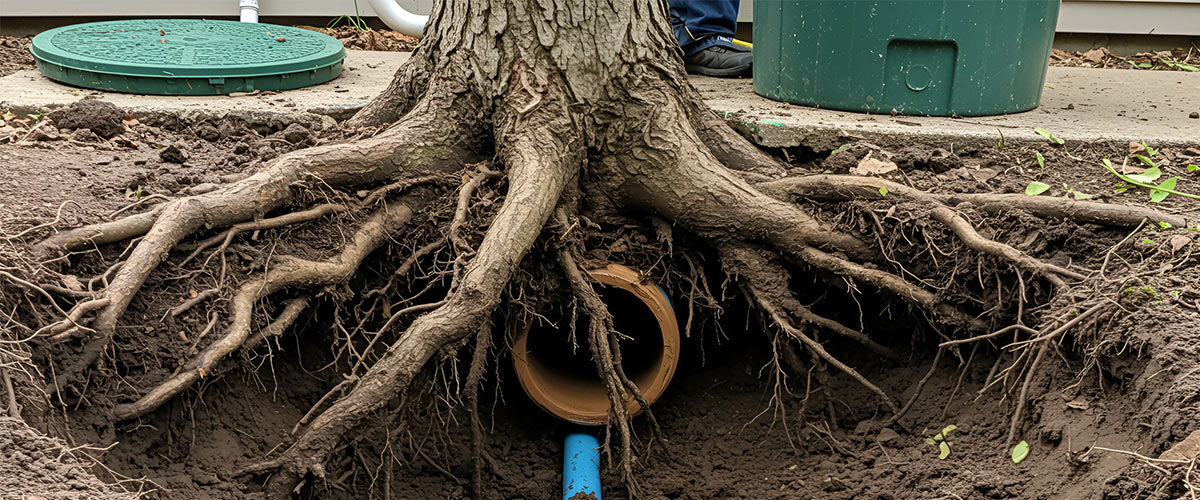Around Winston-Salem, especially in older yards with thirsty maples, roots sniff out every drip in tired clay or cast-iron sewer lines. A hairline crack turns into a root mat, then a stubborn clog, then a full-on backup. I’ve spent twenty years in crawlspaces, coaxing cleanouts and bringing sewer lines back to life. I start with the easy wins—habit from kitchen calls—then move to the main sewer line. Sometimes it’s a five-minute fix; sometimes it’s shovels and saws
Causes for Tree Roots in Sewer Lines
Let’s keep it simple. The only things that belong in a toilet: human waste and toilet paper. That’s it. Not “flushable” wipes. Not paper towels. Those catch on tiny root hairs and create a hidden blockage you can’t see. In the kitchen, treat the sink like a sink, not a trash can. Grease cools and turns to soapstone inside the pipe; it grabs every hair, coffee ground, and eggshell shard sailing by. Long, stringy foods, such as celery and onion skins, twist around cutters; rice and pasta swell like sponges, and coffee grounds settle like sandbars. Then the roots find the mess and move in.
Tree Roots in Sewer Lines – Common Fixes
Start at the lowest fixture that’s acting up—usually a basement toilet or floor drain. If multiple fixtures are slow, think of the main line. Find your outside cleanout cap (usually a white or black cap near the house). Stand to the side and loosen it slowly; pressure releases fast. Use gloves and eye protection. Ensure you use pipe dope rated for sewer gas when you put that cap back.
If you’ve got access and a rental yard nearby, a small drum auger can shave root intrusions enough to get you flowing. Feed the cable slowly, let the cutter do its work, and don’t force it. Stop if the machine stalls or the cable becomes kinked. A toilet auger can clear the bowl, but if the line beyond is hairy, it’ll clog again. For more complex blockages, professional drain cleaning may be necessary.
Foaming root killers (dichlobenil products) can help after mechanical clearing by coating the pipe; they starve hair roots without torching the whole tree. Avoid rock salt—harms lawns and corrodes. If you hear a hollow thunk while pushing the cable, it may indicate a broken section or a shifted clay joint. That’s when it’s time for a camera inspection, not more muscle
Cleaning and Maintenance to Prevent Tree Roots in Sewer Lines
Regular maintenance is your proactive shield against tree roots in sewer lines. If roots were confirmed, have the line mechanically cleaned and treated with a foaming root inhibitor after leaf drop and before spring surge. A quick camera pass maps joints and bellies, and remember, plumbing code says cleanouts must be accessible—use them, don’t bury them under mulch. Keep the cap snug; rainwater sneaking in adds load and invites more growth.
Plant smart. Keep small ornamental plants 10 feet from the lateral; big thirsties like willow or silver maple 25–30 feet away. In older homes in West End, I see clay tile with mortar joints—prime targets. Our clay soil retains moisture around those joints, allowing roots to linger and thicken. If you’re redoing landscaping, consider root barriers parallel to the line.
Run hot water after using the disposal. Never pour curing cement, grout slurry, or paint down drains. Enzymes are fine for organic film, but they won’t melt roots. Watch low spots in the yard: lush green strip in July, spongy ground after dry weeks—those are waving flags. For homeowners dealing with persistent issues, this community discussion offers valuable insights from others who’ve faced similar challenges.
When to Call Professionals for Tree Roots in Sewer Lines
If sewage backs into a tub on the lowest level, stop using water and call. If the issue repeats within a month of the fix, call. If you open the cleanout and see standing water at the rim, that’s a full pipe, not a slow drain. We’ll camera the line, jet or cut the roots with a sectional cutter, and show you exactly where the intrusion lives. Trenchless options—such as pipe lining or bursting—can replace damaged pipes without turning the yard into a construction site.
While we’re onsite, we will also check the house pressure. The pressure in most houses is about 50 PSI. Anything above 80 can cause problems with older fixtures. Not a sewer issue, but small leaks can raise water bills and saturate the soil near the lateral. If we smell that rotten-egg edge or hear gurgles after a flush, I’m mapping vents too; bad venting can mimic clogs.
If the line is Orangeburg or cracked cast iron, replacement saves you from the third emergency at 2 a.m. We’ll pull permits, mark utilities, and keep the timeline tight. For comprehensive solutions, our full range of plumbing services can address any related issues.
Frequently Asked Questions About Tree Roots in Sewer Lines
What are the first signs of tree roots in sewer lines?
Multiple slow fixtures, toilet bubbles when the washer drains, gurgling, a sewer smell near a floor drain, and a greener-than-normal strip in the yard are early signs of tree roots in sewer lines
Will cutting roots prevent tree roots from forming in sewer lines forever?
No. The roots will regrow. Mechanical clearing, combined with a foaming inhibitor and, if necessary, lining/replacement, is the lasting solution.
Is copper sulfate safe?
It can harm plants and waterways; use a foaming, targeted product, and only after clearing the roots. Keep it out of streams and wells.
Can I use a rental machine to DIY remove tree roots from my sewer lines?
Sometimes, for light hair roots. If the cable binds, trips the breaker, or you encounter a void, stop and call a professional.
How long does trenchless lining last?
Typically, decades when installed correctly on a cleaned, prepped pipe. We warranty our work and show before/after footage.

